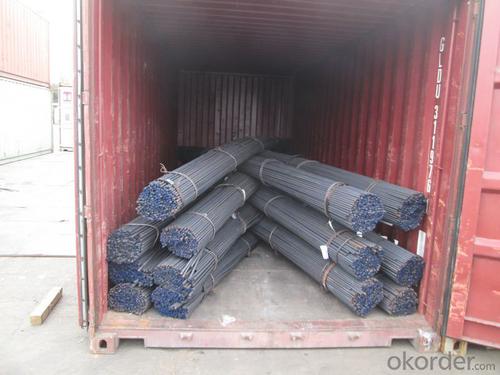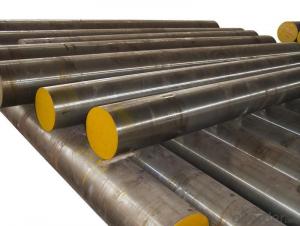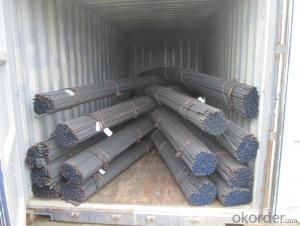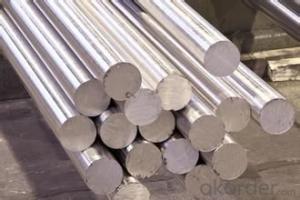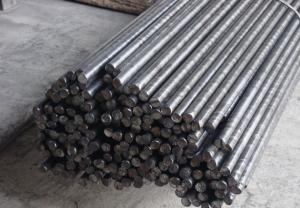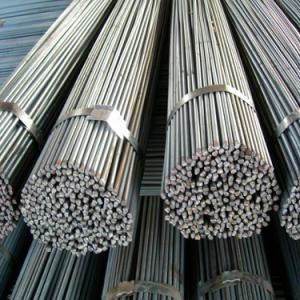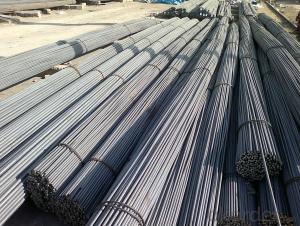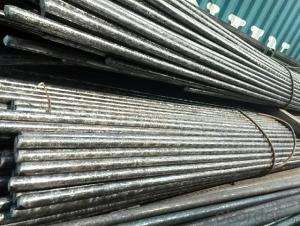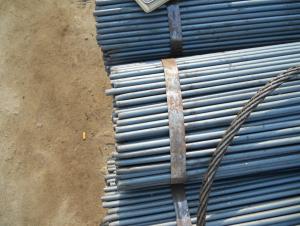Q235 Bearing Steel Round Bar Product with high quality
- Loading Port:
- Tianjin
- Payment Terms:
- TT or LC
- Min Order Qty:
- 25 m.t.
- Supply Capability:
- 7000 m.t./month
OKorder Service Pledge
OKorder Financial Service
You Might Also Like
Specification
OKorder is offering Q235 Bearing Steel Round Bar Product with high quality with worldwide shipping. Our supplier is a world-class manufacturer of steel, with our products utilized the world over. OKorder annually supplies products to European, North American and Asian markets. We provide quotations within 24 hours of receiving an inquiry and guarantee competitive prices.
Product Applications:
Q235 Bearing Steel Round Bar Product with high quality are ideal for structural applications and are widely used in the construction of buildings and bridges, and the manufacturing, petrochemical, and transportation industries.
Product Advantages:
OKorder's Q235 Bearing Steel Round Bar Product with high quality are durable, strong, and resist corrosion.
Main Product Features:
· Premium quality
· Prompt delivery & seaworthy packing (30 days after receiving deposit)
· Corrosion resistance
· Can be recycled and reused
· Mill test certification
· Professional Service
· Competitive pricing
Product Description:
Specifications of Steel Round Bar Products
1. Grade: Q235, A36, SS400, S235JR
2. Feature: Unbreakable, grinding resistant and high impact value
3. Diameter: 8mm-150mm
4. Performance: Mainly for civil construction
5. Characteristics: Even hardness, no deformation, no breaking, no mal-roundness
6. Technique: Hot rolled
7. Mass: Mass (kg/m) = Diameter (mm) × Diameter (mm) × 0.00617
Usage and Applications of Steel Round Bar Products
1. Steel round bar products is used in construction and a large number of architectural and engineering structures. And it can be used in production of handrail, windows, machinery, telecom and curtain wall.
2. It can be used in the fields like metal mines, cement plants, water coal slurry, power stations and chemical industry.
3. Besides, we can supply some especial material steel round bar that can be used for main shaft of steamer, hummer shank, with big section and supper force.
4. Recommended watchcase factory, screw factory and other cold stamping products industry use.
Packaging & Delivery of Steel Round Bar Products
Packaging Detail: All goods are packed in bundle with steel strips and shipped by break bulk vessel or container (depend on target market and different ports)
Delivery Detail: 45 days
Trade terms: FOB, CFR, CIF
MOQ: 25 tons per specification; we can negotiate the quantity if the specification is normal or we have stock of one specification.
Weight: The price invoicing on theoretical weight basis or actual weight basis depends on customer’s request.
Shipment: The shipment of bulk break or container is depends on customer’s request and the situation of the port of destination.
Documents given: Full set of original clean on board bill of lading; Original signed commercial invoice; Original packing list; Policy of insurance; Certificate of origin and what the target market needs.
Production Flow of Steel Round Bar Products
Material prepare (billet) — heat up — rough rolling — precision rolling — cooling — packing — storage and transportation
Characteristics of Steel Round Bar Products
1. The steel in which the main interstitial alloying constituent is carbon in the range of 0.12–2.0%.
2. As the carbon percentage content rises, steel has the ability to become harder and stronger through heat treating; however it becomes less ductile.
3. Regardless of the heat treatment, higher carbon content reduces weld ability. In carbon steels, the higher carbon content lowers the melting point.
4. Quality should be in conformity with the specification of the manufacturer. Quantity and packing conditions should be in conformity with the term in the contract.
FAQ:
Q1: Why buy Materials & Equipment from OKorder.com?
A1: All products offered byOKorder.com are carefully selected from China's most reliable manufacturing enterprises. Through its ISO certifications, OKorder.com adheres to the highest standards and a commitment to supply chain safety and customer satisfaction.
Q2: How soon can we receive the product after purchase?
A2: Within three days of placing an order, we will begin production. The specific shipping date is dependent upon international and government factors, but is typically 7 to 10 workdays.
Q3: How do we guarantee the quality of our products?
A3: We have established an advanced quality management system which conducts strict quality tests at every step, from raw materials to the final product. At the same time, we provide extensive follow-up service assurances as required.
Images:

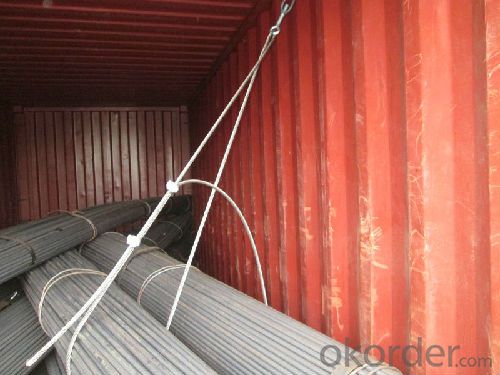
- Q: How do you calculate the weight of a steel round bar based on its length and volume?
- To calculate the weight of a steel round bar based on its length and volume, you would need to know the density of steel, which is approximately 7.85 grams per cubic centimeter. First, calculate the volume of the round bar using the formula for the volume of a cylinder (pi * radius squared * length). Then, multiply the volume by the density to obtain the weight of the steel round bar.
- Q: Can steel round bars be used for making bicycle frames?
- Yes, steel round bars can be used for making bicycle frames. Steel is a commonly used material for bicycle frames due to its strength, durability, and relatively low cost. Steel round bars can be shaped and welded together to create a sturdy and rigid frame that provides stability and support for the rider.
- Q: How do you prevent rust on steel round bars?
- To prevent rust on steel round bars, you can apply a protective coating such as paint, oil, or a rust inhibitor. Regular cleaning and maintenance, including keeping the bars dry and free from moisture, can also help prevent rust formation.
- Q: What is the maximum length of a steel round bar that can be produced?
- Various factors, including the manufacturing process, equipment size and capacity, and logistical constraints, dictate the maximum length of a steel round bar. Typically, steel round bars can range from a few feet to several hundred feet in length. However, it is important to acknowledge that longer lengths may have certain limitations or considerations. For instance, hot rolling mills often determine the maximum length of a steel round bar based on the size and capacity of the rolling mill. The bar's length must fall within a range that the machinery can effectively roll and process. Additionally, transportation and handling logistics can also impose restrictions on the maximum length of a steel bar. Longer bars may necessitate specialized equipment or meticulous planning to ensure safe and efficient movement. Consequently, considering the specific production capabilities and constraints of the steel manufacturer or supplier becomes crucial when determining the maximum length of a steel round bar that can be produced.
- Q: What is the difference between a cold-drawn and a polished steel round bar?
- The manufacturing processes and resulting properties of a cold-drawn steel round bar and a polished steel round bar are different. To produce a cold-drawn steel round bar, a hot-rolled steel bar is pulled or drawn through a die or series of dies at room temperature. This reduces its diameter and increases its length. This process imparts specific characteristics to the steel. Cold-drawn steel bars have a smooth and shiny surface, with tight dimensional tolerances and improved mechanical properties. The cold drawing process refines the microstructure of the steel, making it stronger, more uniform, and less prone to defects. These bars are commonly used in applications that require high strength, precision, and resistance to fatigue, such as automotive components, machinery, and tooling. In contrast, a polished steel round bar undergoes a different treatment process. Once the steel bar is formed, it undergoes polishing, which involves grinding or buffing the surface to achieve a smooth and reflective finish. Polished steel bars have a shiny and mirror-like appearance due to the removal of surface imperfections and contaminants. This process is primarily done for aesthetic purposes and does not significantly alter the mechanical properties of the steel. Polished steel round bars are commonly used in decorative applications, architectural designs, and furniture. In conclusion, the main distinction between a cold-drawn and a polished steel round bar lies in their manufacturing processes and intended applications. Cold-drawn bars go through a precise cold drawing process to enhance their mechanical properties, while polished bars undergo surface polishing for an aesthetically pleasing finish.
- Q: What are the different surface treatments available for stainless steel round bars?
- There are several surface treatments available for stainless steel round bars to enhance their appearance, improve corrosion resistance, and provide added protection. Some of the common surface treatments for stainless steel round bars include: 1. Pickling: This process involves removing any surface impurities or oxides by immersing the stainless steel bar in an acid solution. Pickling helps to restore the stainless steel's natural corrosion resistance and creates a smooth and clean surface. 2. Passivation: Passivation is a chemical treatment that forms a thin, protective layer on the surface of stainless steel. By removing free iron and other contaminants, passivation helps to enhance the stainless steel's resistance to corrosion. 3. Electropolishing: This treatment involves applying an electric current to the stainless steel round bar while immersed in an electrolyte solution. Electropolishing removes a thin layer of material from the surface, resulting in a smooth, shiny, and corrosion-resistant finish. 4. Grinding and Polishing: Grinding and polishing are mechanical processes used to improve the surface finish of stainless steel round bars. Grinding involves removing any imperfections or roughness, while polishing creates a smooth and reflective surface. 5. Coating: Coating stainless steel round bars with a protective layer can provide additional corrosion resistance. Common coatings include electroplating with zinc or nickel, as well as applying organic coatings like paints or powder coatings. 6. Shot blasting: This treatment involves bombarding the stainless steel round bar's surface with small metallic or non-metallic particles at high velocity. Shot blasting removes any surface contaminants, scales, or oxides, resulting in a clean and textured surface. It is important to note that the choice of surface treatment depends on the desired end-use application, as well as the specific requirements for appearance and corrosion resistance. Consulting with a professional or manufacturer can help determine the most suitable surface treatment for stainless steel round bars.
- Q: What's the difference between round steel and screw steel? Which is cheaper than steel on the market these days?
- Round steel and thread steel are mainly made of different materials and purposes, so prices are different, and they need to be chosen according to actual needs.
- Q: Can steel round bars be used for making interior components?
- Indeed, the utilization of steel round bars in the creation of interior components is viable. Steel, being both sturdy and adaptable, can be molded and fashioned into a plethora of different designs and structures. Specifically, round bars are exceptionally well-suited for crafting interior components including handrails, staircases, furniture frames, and decorative elements. They offer not only robustness and stability, but also an appealing aesthetic to interior spaces. Moreover, steel round bars can be effortlessly welded, bent, or cut to fulfill particular design specifications, rendering them an optimal selection for bespoke interior components.
- Q: What are the different types of steel round bars used in the manufacturing of gears?
- There are several types of steel round bars commonly used in the manufacturing of gears. Some of the most common ones include alloy steel round bars, carbon steel round bars, stainless steel round bars, and tool steel round bars. These steel round bars offer different properties and characteristics that are suitable for various gear applications, such as high strength, durability, wear resistance, and corrosion resistance. The specific type of steel round bar used depends on the specific requirements of the gear and the operating conditions it will be subjected to.
- Q: What are the different types of steel round bar surface finishes for improved cleanliness?
- There are several types of steel round bar surface finishes that can be used to improve cleanliness. 1. Bright Surface Finish: This is achieved by polishing the steel round bar, resulting in a smooth and reflective surface. Bright surface finishes are commonly used in applications where cleanliness and appearance are important, such as in the manufacturing of kitchen appliances or decorative items. 2. Satin Finish: This finish is achieved by brushing the steel round bar with fine abrasive pads, resulting in a smooth and matte surface. Satin finishes are often used in applications where a clean and modern aesthetic is desired, such as in architectural designs or furniture manufacturing. 3. Pickled Finish: This finish involves immersing the steel round bar in an acid solution, which removes any impurities or oxides from the surface. Pickled finishes are commonly used in applications where the steel round bar will be further processed, such as in the production of pipes or tubes. 4. Passivated Finish: This finish involves treating the steel round bar with a chemical solution, which forms a protective oxide layer on the surface. Passivated finishes are used to enhance the corrosion resistance of the steel round bar, making it suitable for applications in harsh or corrosive environments. 5. Shot Blasted Finish: This finish involves propelling small metal or ceramic particles at high velocity onto the surface of the steel round bar. Shot blasting removes any scale, rust, or surface contaminants, resulting in a clean and textured surface. Shot blasted finishes are commonly used in applications where a good bond between the steel round bar and another material, such as paint or coating, is required. Overall, the choice of steel round bar surface finish depends on the specific application and the desired level of cleanliness. Each finish offers unique properties and benefits, allowing for improved cleanliness and performance in various industries.
Send your message to us
Q235 Bearing Steel Round Bar Product with high quality
- Loading Port:
- Tianjin
- Payment Terms:
- TT or LC
- Min Order Qty:
- 25 m.t.
- Supply Capability:
- 7000 m.t./month
OKorder Service Pledge
OKorder Financial Service
Similar products
Hot products
Hot Searches
Related keywords


